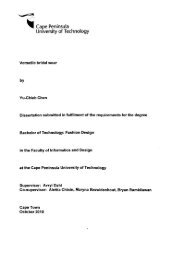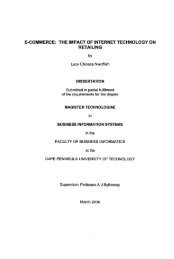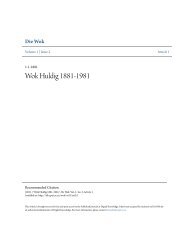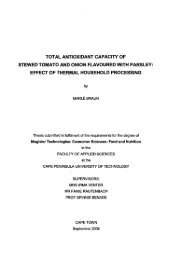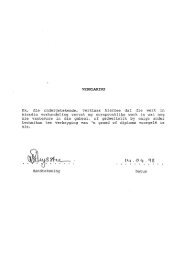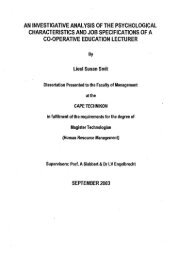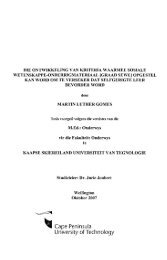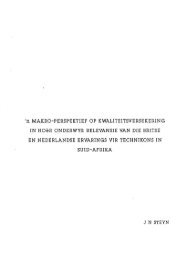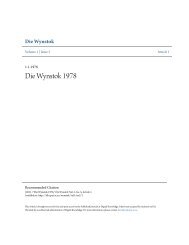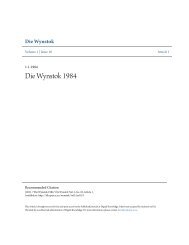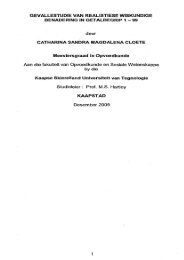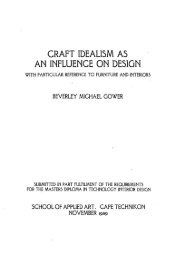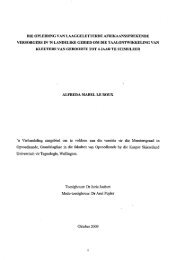the effect of the particle size distribution on non-newtonian turbulent ...
the effect of the particle size distribution on non-newtonian turbulent ...
the effect of the particle size distribution on non-newtonian turbulent ...
You also want an ePaper? Increase the reach of your titles
YUMPU automatically turns print PDFs into web optimized ePapers that Google loves.
Chapter 5 Discussi<strong>on</strong> Page 5.13<br />
5.7 CONCLUSIONS<br />
Experimental work has been c<strong>on</strong>ducted using homogeneous n<strong>on</strong>-Newt<strong>on</strong>ian slurries and <str<strong>on</strong>g>the</str<strong>on</strong>g><br />
analysis and discussi<strong>on</strong> <str<strong>on</strong>g>of</str<strong>on</strong>g> <str<strong>on</strong>g>the</str<strong>on</strong>g> results has been presented. As can be seen from <str<strong>on</strong>g>the</str<strong>on</strong>g> results<br />
Slatter's model best predicts <str<strong>on</strong>g>the</str<strong>on</strong>g> <strong>turbulent</strong> flow <str<strong>on</strong>g>of</str<strong>on</strong>g> <str<strong>on</strong>g>the</str<strong>on</strong>g> <str<strong>on</strong>g>the</str<strong>on</strong>g>oretical models which were<br />
c<strong>on</strong>sidered. From <str<strong>on</strong>g>the</str<strong>on</strong>g> evidence it can be c<strong>on</strong>cluded that <str<strong>on</strong>g>the</str<strong>on</strong>g>oretical models based <strong>on</strong> <str<strong>on</strong>g>the</str<strong>on</strong>g><br />
<str<strong>on</strong>g>particle</str<strong>on</strong>g> roughness <str<strong>on</strong>g>effect</str<strong>on</strong>g> are justified in adopting <str<strong>on</strong>g>the</str<strong>on</strong>g> approach and in fact <str<strong>on</strong>g>the</str<strong>on</strong>g> <str<strong>on</strong>g>particle</str<strong>on</strong>g><br />
roughness <str<strong>on</strong>g>effect</str<strong>on</strong>g> which does exist should be c<strong>on</strong>sidered in <strong>turbulent</strong> flow analysis. There is<br />
room for improving <strong>on</strong> <str<strong>on</strong>g>the</str<strong>on</strong>g> Slatter model and fur<str<strong>on</strong>g>the</str<strong>on</strong>g>r test work should be c<strong>on</strong>ducted to fur<str<strong>on</strong>g>the</str<strong>on</strong>g>r<br />
vindicate or disprove <str<strong>on</strong>g>the</str<strong>on</strong>g> assumpti<strong>on</strong> <strong>on</strong> which <str<strong>on</strong>g>the</str<strong>on</strong>g> model is based but <str<strong>on</strong>g>the</str<strong>on</strong>g> <str<strong>on</strong>g>particle</str<strong>on</strong>g> roughness<br />
<str<strong>on</strong>g>effect</str<strong>on</strong>g> is defmitely a viable starting point to c<strong>on</strong>sider in <str<strong>on</strong>g>the</str<strong>on</strong>g> <strong>turbulent</strong> flow <str<strong>on</strong>g>of</str<strong>on</strong>g> homogeneous<br />
n<strong>on</strong>-Newt<strong>on</strong>ian suspensi<strong>on</strong>s. The following c<strong>on</strong>clusi<strong>on</strong>s can be drawn from <str<strong>on</strong>g>the</str<strong>on</strong>g> discussi<strong>on</strong><br />
<str<strong>on</strong>g>of</str<strong>on</strong>g> <str<strong>on</strong>g>the</str<strong>on</strong>g> results and analysis <str<strong>on</strong>g>of</str<strong>on</strong>g> <str<strong>on</strong>g>the</str<strong>on</strong>g> test data:<br />
• A <str<strong>on</strong>g>particle</str<strong>on</strong>g> roughness <str<strong>on</strong>g>effect</str<strong>on</strong>g> does exist.<br />
• Fur<str<strong>on</strong>g>the</str<strong>on</strong>g>r investigati<strong>on</strong> is required and a large data base should be established to<br />
accurately determine <str<strong>on</strong>g>the</str<strong>on</strong>g> limit <str<strong>on</strong>g>of</str<strong>on</strong>g> validity <str<strong>on</strong>g>of</str<strong>on</strong>g> <str<strong>on</strong>g>the</str<strong>on</strong>g> <str<strong>on</strong>g>particle</str<strong>on</strong>g> roughness <str<strong>on</strong>g>effect</str<strong>on</strong>g><br />
• The d 85 <str<strong>on</strong>g>size</str<strong>on</strong>g> does not necessarily give <str<strong>on</strong>g>the</str<strong>on</strong>g> best representative <str<strong>on</strong>g>particle</str<strong>on</strong>g> <str<strong>on</strong>g>size</str<strong>on</strong>g> for <str<strong>on</strong>g>the</str<strong>on</strong>g><br />
<str<strong>on</strong>g>particle</str<strong>on</strong>g> roughness <str<strong>on</strong>g>effect</str<strong>on</strong>g> but will depend <strong>on</strong> <str<strong>on</strong>g>the</str<strong>on</strong>g> shape <str<strong>on</strong>g>of</str<strong>on</strong>g> <str<strong>on</strong>g>the</str<strong>on</strong>g> PSD.<br />
• The viscous sub-layer cannot exist if it is smaller than <str<strong>on</strong>g>the</str<strong>on</strong>g> <str<strong>on</strong>g>particle</str<strong>on</strong>g>s which comprise<br />
<str<strong>on</strong>g>the</str<strong>on</strong>g> slurry and <str<strong>on</strong>g>the</str<strong>on</strong>g> c<strong>on</strong>tinuum approximati<strong>on</strong> must be compromised in <strong>turbulent</strong> flow<br />
analysis.<br />
• The viscous sub-layer breaks down for Re, > 3,32 which is at a viscous sub-layer<br />
thickness <str<strong>on</strong>g>of</str<strong>on</strong>g> approximately" = 3*d 85 for <str<strong>on</strong>g>the</str<strong>on</strong>g> Slatter model. For <str<strong>on</strong>g>the</str<strong>on</strong>g> Maude &<br />
Whitmore (1956, 1958) correlati<strong>on</strong> <str<strong>on</strong>g>the</str<strong>on</strong>g> viscous sub-layer breaks down when <str<strong>on</strong>g>the</str<strong>on</strong>g><br />
<str<strong>on</strong>g>particle</str<strong>on</strong>g> diameter is greater than half <str<strong>on</strong>g>the</str<strong>on</strong>g> thickness <str<strong>on</strong>g>of</str<strong>on</strong>g> <str<strong>on</strong>g>the</str<strong>on</strong>g> viscous sub-layer. Fur<str<strong>on</strong>g>the</str<strong>on</strong>g>r<br />
investigati<strong>on</strong> is required to accurately predict <str<strong>on</strong>g>the</str<strong>on</strong>g> exact point at which <str<strong>on</strong>g>the</str<strong>on</strong>g> viscous sub-



